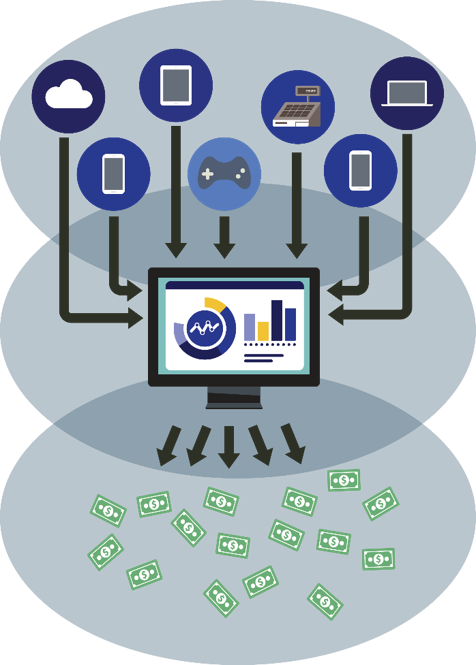![]() The science of software monetization is revolutionizing all disciplines of technology, and is driving record valuations in software M&A. The key to value is finding more and more information about how customers use your software, when they pay for it, and why they spend even more, then to quickly update your software to monetize more efficiently.
The science of software monetization is revolutionizing all disciplines of technology, and is driving record valuations in software M&A. The key to value is finding more and more information about how customers use your software, when they pay for it, and why they spend even more, then to quickly update your software to monetize more efficiently.
We saw this emerge in the games industry a few years ago, with game studios in Korea and China carefully gathering detailed data on who their players were, and how they spent money. The free to play model, where consumers get to try the software before they buy it and then pay for what they like, started in the shareware days of games in the 1990s. Hits like Wolfenstein, Doom, and Duke Nukem built billion dollar franchises based on this model.
 Then the games industry went commercial, with expensive box product on retail shelves – consumers were not sure what they were buying, but took a chance. Fast forward to now, where most games are online and/or mobile, and free to play. Korea and China perfected this by tracking everything a consumer does, monitoring what they liked, where they played most and what they paid for. Smart developers worldwide started using this model, largely based on the shareware model, to carefully monetize their players. Small studios now had the chance to make huge hits and get rich using this model. Some of the most successful studios today were built from small 2 or 3 person shops following this method.
Then the games industry went commercial, with expensive box product on retail shelves – consumers were not sure what they were buying, but took a chance. Fast forward to now, where most games are online and/or mobile, and free to play. Korea and China perfected this by tracking everything a consumer does, monitoring what they liked, where they played most and what they paid for. Smart developers worldwide started using this model, largely based on the shareware model, to carefully monetize their players. Small studios now had the chance to make huge hits and get rich using this model. Some of the most successful studios today were built from small 2 or 3 person shops following this method.
This is the Science of Data Monetization. And it is spreading to all genres of software. Tracking what your customer does with the software, what they ignore, what they pay for, and what they buy more of, is what it’s all about. You just can’t fool your customers these days. They will try and only buy what has value to them. And it’s the goal of the best software companies to constantly monitor this and be agile enough to deliver solutions as quickly as possible.
This has led to a flurry of M&A for both software analytics firms (GamesAnalytics acquired by Mobvista out of China,) and software studios, especially game companies that have perfected this model – witness Corum-clients JAGEX being acquired by Zhongji for their wildly successful RuneScape franchise and Digital Extremes with their free to play smash hit Warframe! These games monetize incredibly well, thanks to the brilliance of data scientists in those companies that have monetized their games so profitably.
In addition, video ads are benefiting from this trend, with Facebook being a key beneficiary, something driven by their acquisition of LiveRail a couple years ago. Adobe may be trying to follow suit with their half-billion acquisition of TubeMogul in November. In general, any SaaS provider tracking successful and unsuccessful strategies within an ecosystem can provide this monetization capability to their customers, for everyone’s benefit.
The key goal here for every software company is to find the shortest possible distance between the data and the money. From an M&A perspective, the better the analytics, the more attractive and valuable a company is.
For more of Corum’s Top Disruptive Tech Trends of 2017, click here.
